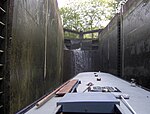Lyncombe, Bath

Lyncombe is a district and electoral ward in Bath, Somerset, and a former parish in the Diocese of Bath and Wells. In the mid-19th century the parish was formed when the parish of Widcombe and Lyncombe was split in two, but it was abolished in the late 1960s. The village of Lyncombe existed since at least the Saxon period prior to becoming part of the City of Bath. Lyncombe takes its name from the Celtic word cwm meaning valley, with the Lyn being the name of the stream that runs through it. The present day district is approximately centred on the Western part of this valley, known as Lyncombe Vale, and extends down to the more urban area around the River Avon across from Bath Spa railway station. The northern area of the electoral ward is known as Bear Flat.The electoral ward was merged with Widcombe at the boundary changes effected at the elections held on 2 May 2019.
Excerpt from the Wikipedia article Lyncombe, Bath (License: CC BY-SA 3.0, Authors, Images).Lyncombe, Bath
Kipling Avenue, Bath Bear Flat
Geographical coordinates (GPS) Address Phone number Website Nearby Places Show on map
Geographical coordinates (GPS)
| Latitude | Longitude |
|---|---|
| N 51.373 ° | E -2.3563 ° |
Address
Beechen Cliff School
Kipling Avenue
BA2 4RE Bath, Bear Flat
England, United Kingdom
Open on Google Maps








